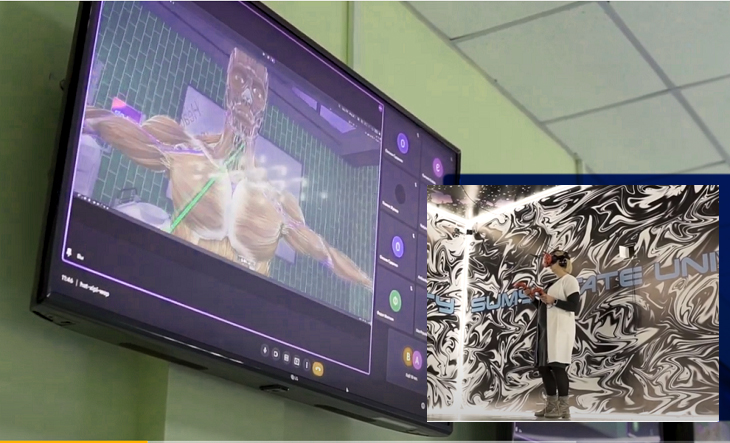The academic and research laboratory of virtual (VR) and augmented reality (AR) “Ulab” has been operating at Sumy State University for two years. It was created for the use of immersive technologies in the educational process (or the integration of virtual content into the physical environment).
The advantage of such technologies is a significantly higher level of student involvement, the possibility of realistic immersion in situations and processes that are extremely difficult and sometimes impossible to reproduce in the classroom. Immersive technologies make it possible to study the technological process and even simulate an accident at a large industrial facility. They also allow future officers to master unique skills in combat conditions, explore phobias and psychological reactions to atypical situations, etc.
Ample opportunities of the virtual and augmented reality implementation using a detailed virtual anatomical model of a person are open to students of the Medical Institute of Sumy State University. The virtual anatomical model’s peculiar features are the high level of detailing and quality of 3D visualization, as well as its mobility. It allows students to study anatomy, examine every muscle, organ, bone, etc., disassemble the body as a constructor and simulate clinical situations where a virtual patient moves like a real person in a virtual clinic. Moreover, different actions can be performed on him or her.
“While Sumy region was in the red quarantine zone and lessons were held in webinar form, “Ulab” laboratory specialists offered SumDU teachers to broadcast for students directly via virtual reality. Certainly, this is not as realistic for students as direct immersion in VR, but they perceive it with great enthusiasm and admiration when compared to the usual presentations and video broadcasts,” says Yuriy ZUBAN, director of Organizational and Methodological E-learning Technology Center.
Such approach is easily scaled to a large online audience, dramatically expands the teacher's capabilities in terms of visual demonstrations of objects and actions. Furthermore, verbal communication with students makes it possible to implement various methodological approaches and models in the study of medical subjects.
Oksana MELEKHOVETS, associate professor of the Family Medicine Department at Medical Institute of SumDu, practicing physician, the author of the first augmented reality study guide "Diabetus Meletus" in SumDU and an active participant in SumDU pedagogical experiment on blended learning, extensively applies the latest technological solutions during her lessons.
Ms. Oksana comments on her impressions of the technology use, “These are different emotions, a different state, a different visualization and a different detailing of any processes. The use of augmented reality allows you to achieve the level of the material retention that any teacher dreams of.”
Medical students themselves also speak about the advantages of using immersive technologies in the educational process. They point out that virtual reality lessons are a unique experience that gives much more knowledge than just studying the corresponding literature.


 укр
укр  eng
eng 